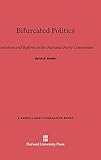Bifurcated Politics : Evolution and Reform in the National Party Convention / Byron E. Shafer.
Material type: TextSeries: A Russell Sage Foundation StudyPublisher: Cambridge, MA : Harvard University Press, [2013]Copyright date: ©1988Edition: Reprint 2014Description: 1 online resource (391 p.) : illustrationsContent type:
TextSeries: A Russell Sage Foundation StudyPublisher: Cambridge, MA : Harvard University Press, [2013]Copyright date: ©1988Edition: Reprint 2014Description: 1 online resource (391 p.) : illustrationsContent type: - 9780674421615
- 9780674421622
- 324.5/6/0973
- JK2255
- online - DeGruyter
| Item type | Current library | Call number | URL | Status | Notes | Barcode | |
|---|---|---|---|---|---|---|---|
 eBook
eBook
|
Biblioteca "Angelicum" Pont. Univ. S.Tommaso d'Aquino Nuvola online | online - DeGruyter (Browse shelf(Opens below)) | Online access | Not for loan (Accesso limitato) | Accesso per gli utenti autorizzati / Access for authorized users | (dgr)9780674421622 |
Frontmatter -- Contents -- Introduction. National Party Conventions in American Politics: The Attractions of the Convention -- 1. The Nomination and the Convention: An Informal Disappearance -- 2. Institutionalizing the Disappearance: The Nomination after Reform -- 3. Changing Contours of Delegate Selection: The Decline of the Official Party -- 4. The Rise of the Organized Interests: An Alternative Base for Delegate Selection -- 5. The Convention and the Election: The Structure of Conflict inside the Hall -- 6. Recurring Struggles over Tangible Products: Traditional Activities in the Reformed Convention -- 7. The Struggle over the Mediated Convention: Televised Coverage and Public Perception -- 8. Coverage Levels and Institutional Character: The Coming of the Bifurcated Convention -- Conclusion. Evolution and Reform: The Convention and a Changing American Politics -- Afterword Evolution. and Reform beyond 1988: The Future of the National Party Convention -- Notes -- Acknowledgments and Project History -- Index
restricted access online access with authorization star
http://purl.org/coar/access_right/c_16ec
Even today, when it is often viewed as an institution in decline, the national party convention retains a certain raw, emotional, populist fascination. Bifurcated Politics is a portrait of the postwar convention as a changing institution—a changing institution that still confirms the single most important decision in American politics. With the 1988 elections clearly in mind, Byron E. Shafer examines the status of the national party convention, which is created and dispersed within a handful of days but nevertheless becomes a self-contained world for participants, reporters, and observers alike. He analyzes such dramatic developments as the disappearance of the contest over the presidential nomination and its replacement by struggles over the publicizing of various campaigns, the decline of party officials and the rise of the organized interests, and the large and growing disjunction between what is happening at the convention hall and what the public sees—between the convention on site and the convention on screen. He argues that, despite its declining status, the postwar convention has attracted—and mirrored—most of the major developments in postwar politics: the nationalization of that politics and the spread of procedural reform, a changing connection between the general public and political institutions, even the coming of a new and different sort of American politics. Bifurcated Politics tells the story of most of the postwar conventions, along with the nominating campaigns that preceded them. But it also develops a picture of the changing American politics around those stories. It will become the definitive study of the national party convention.
Mode of access: Internet via World Wide Web.
In English.
Description based on online resource; title from PDF title page (publisher's Web site, viewed 29. Nov 2021)


